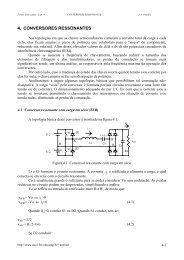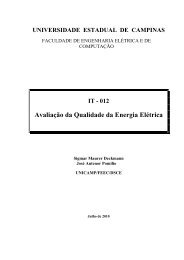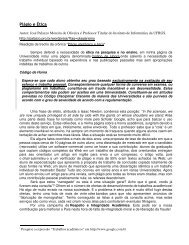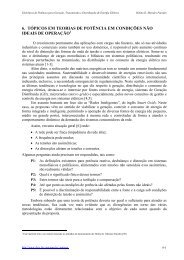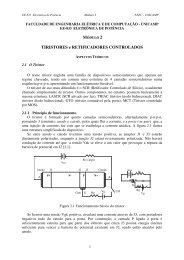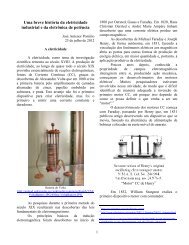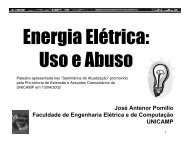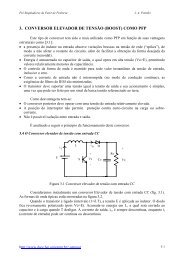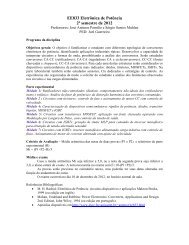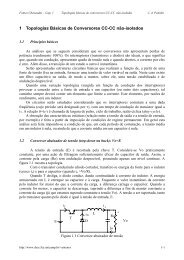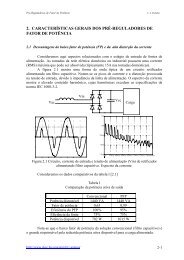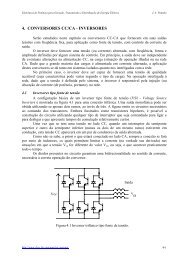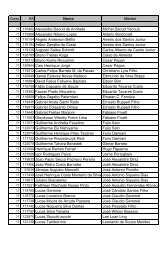Controle Direto de Torque do Motor de Indução ... - D.s.c.e. - Unicamp
Controle Direto de Torque do Motor de Indução ... - D.s.c.e. - Unicamp
Controle Direto de Torque do Motor de Indução ... - D.s.c.e. - Unicamp
You also want an ePaper? Increase the reach of your titles
YUMPU automatically turns print PDFs into web optimized ePapers that Google loves.
52 <strong>Controle</strong> <strong>Direto</strong> <strong>de</strong> <strong>Torque</strong> <strong>do</strong> <strong>Motor</strong> <strong>de</strong> <strong>Indução</strong> Trifásico<br />
Substituin<strong>do</strong> (3.66) em (3.64), tem-se que:<br />
Tem = 3P<br />
2 ψsiqs<br />
iqs = 2 Tem<br />
3P ψs<br />
uqs = 2<br />
3P Rs<br />
Tem<br />
+ωsψs<br />
ψs<br />
(3.65)<br />
(3.66)<br />
(3.67)<br />
Então, através <strong>do</strong> erro <strong>do</strong> fluxo <strong>do</strong> estator e <strong>do</strong> torque eletromagnético é possível produzir os<br />
valores <strong>de</strong>sacopla<strong>do</strong>s <strong>de</strong> referência, das componentes real e imaginário, <strong>do</strong> vetor espacial da tensão<br />
<strong>do</strong> estator através <strong>do</strong>s controla<strong>do</strong>res PI com a finalida<strong>de</strong> <strong>de</strong> minimizar os erros <strong>do</strong> fluxo <strong>do</strong> estator e<br />
<strong>do</strong> torque eletromagnético [20], [14].<br />
Observa-se a partir da equação (3.63) que o fluxo <strong>do</strong> estator é controla<strong>do</strong> através da componente<br />
realuds <strong>do</strong> vetor espacial da tensão <strong>do</strong> estator. Para cada perío<strong>do</strong> <strong>de</strong> amostragemTs, a equação (3.63)<br />
po<strong>de</strong>-se aproximar por:<br />
uds = Rsids +∆ψs/Ts<br />
(3.68)<br />
Para o caso quan<strong>do</strong> o MIT opera em altas velocida<strong>de</strong>sRsids po<strong>de</strong> ser <strong>de</strong>spreza<strong>do</strong> e a tensão po<strong>de</strong><br />
chegar a ser proporcional com a mudança <strong>do</strong> fluxo <strong>do</strong> estator∆ψs e com a frequência <strong>de</strong> chaveamento<br />
1/Ts. No entanto, a baixas velocida<strong>de</strong>s Rsids não é <strong>de</strong>sprezível. Então, para evitar o uso <strong>de</strong> uma<br />
transformação <strong>de</strong> coor<strong>de</strong>nadas para calcular a corrente no sistema <strong>de</strong> referência alinha<strong>do</strong> com fluxo<br />
<strong>do</strong> estator e calcular a queda na resistência <strong>do</strong> estator, será utiliza<strong>do</strong> um controla<strong>do</strong>r PI para a malha<br />
<strong>de</strong> controle <strong>do</strong> fluxo <strong>do</strong> estator, então:<br />
u ∗ ds = (KPψ +KIψ/s)(ψ ∗ s − ˆ ψs) (3.69)<br />
Na equação (3.67) tem-se que a componente imaginária uqs <strong>do</strong> vetor espacial da tensão <strong>do</strong> esta-<br />
tor, se o termo ωsψs fosse <strong>de</strong>s-acopla<strong>do</strong>, controla o torque eletromagnético. Uma forma simples <strong>de</strong><br />
realizar o <strong>de</strong>sacoplamento é somar o termo <strong>de</strong>pen<strong>de</strong>nte da velocida<strong>de</strong>ωsψs à saída <strong>do</strong> controla<strong>do</strong>r <strong>do</strong><br />
torque eletromagnético, isto é:<br />
u ∗ qs = (KPTem +KITem/s)(T ∗ em − ˆ Tem)+ωsψs<br />
(3.70)<br />
Em [21] a velocida<strong>de</strong> <strong>do</strong> fluxo <strong>do</strong> estator ωs é calcula<strong>do</strong> no sistema <strong>de</strong> referência estacionário a<br />
partir <strong>de</strong> duas estimativas sucessivas <strong>do</strong> fluxo <strong>do</strong> estatorψs(k) eψs(k +1), ou seja:



